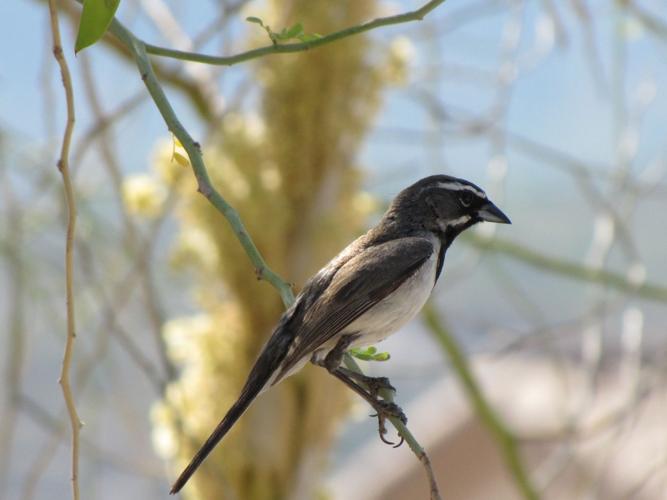Living in the Arizona Upland part of the Sonoran Desert has advantages for bird lovers. We regularly see birds that people across the U.S. travel great distances to find. One of these, and my favorite sparrow, is the beautiful Black-throated Sparrow. If your lot borders open desert scrub, you no doubt see this striking bird often. Even if you live, like I do, on a hemmed-in lot with no direct access to open area, you will still sometimes see Black-throated Sparrows. They clearly have moved deeper into SaddleBrooke in the ten years we’ve lived here. We saw none in our yard for the first six years, but now increasingly spot them, and having seen juvenile birds as well as adults, I suspect they have even nested in some corner of our yard.
Once fittingly known as the Desert Sparrow, the Black-throated Sparrow was first collected in 1850 by John Woodhouse Audubon, the son of the famous bird artist, John James Audubon, and named that same year. Whatever your source for information about the bird, it invariably includes comments such as handsome, beautiful and striking. Its voice is similarly described as tinkling and bell-like. And, indeed, striking is quite descriptive, since the bird’s coloration is limited to shades of black and white. It’s impressive that a bird can be so eye-catching without a single red or yellow feather.
Black-Throats are currently breeding, nesting and fledging their young, their first of at least two annual broods. They nest close to the ground, often in cholla, bursage and palo verde, and frequently just a foot or less above the ground. Females incubate the three to four eggs about 12 days and the young continue to get care and attention from both parents for another three weeks or so. They do eat seeds, but prefer insects, the exclusive diet for those still in the nest.
Besides being beautiful and singing melodiously, Black-throated Sparrows are considered Arizona’s most numerous and widespread sparrow, and rank seventh on the list of most frequently reported breeding birds in Arizona. Obviously, this is a bird that would offer some competition to the Cactus Wren if we were to reconsider our official state bird.
This also is a bird that socializes with other birds, especially other sparrows, and can often be found in the midst of a flock of White-Crowned or Chipping Sparrows. The next time you shrug your shoulders at a bunch of common House Sparrows, take a closer look. You might be lucky enough to spot one of my favorite birds.





